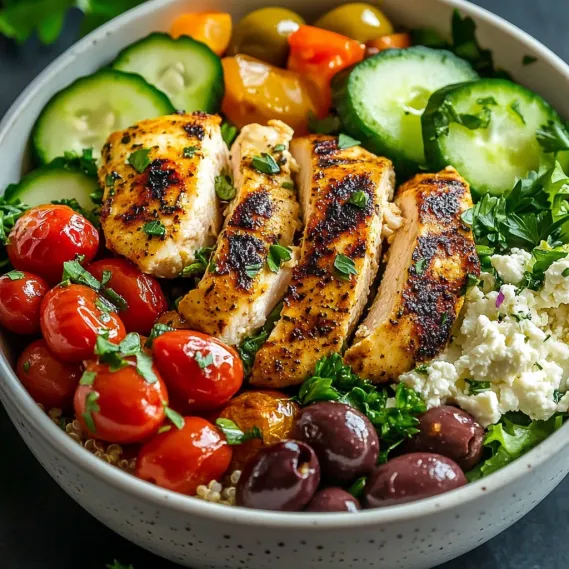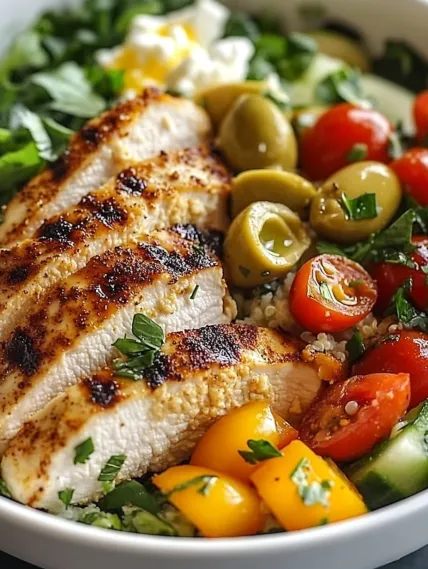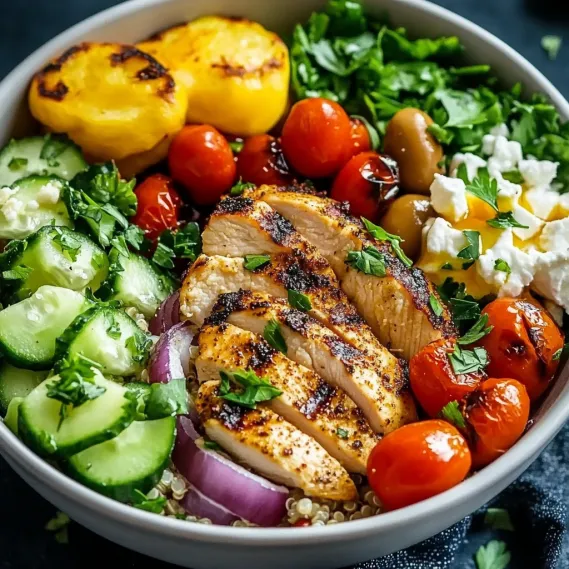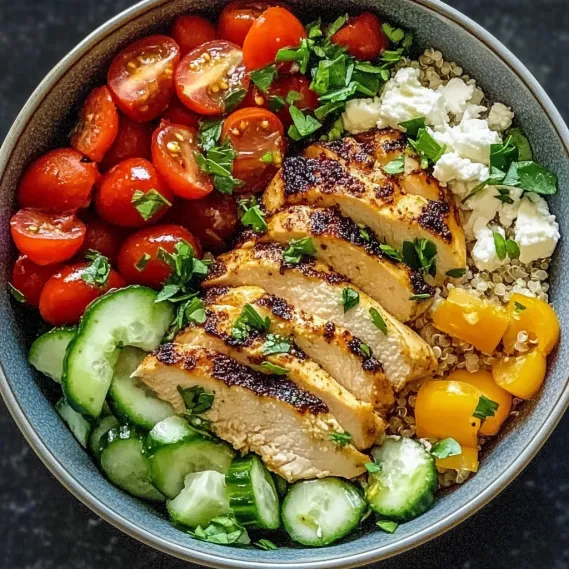 Pin it
Pin it
This vibrant Mediterranean Chicken Bowl brings together tender, spice-marinated chicken with fresh vegetables, hearty grains, and creamy hummus for a balanced meal bursting with flavor. Inspired by the healthy eating traditions of the Mediterranean region, this dish offers a perfect combination of protein, fiber, and healthy fats in one beautiful bowl. I discovered this recipe while searching for nutritious meal prep options and was amazed by how satisfying yet wholesome it is.
Last month, I served these bowls at a casual dinner gathering, and my friend who's usually skeptical of 'healthy food' couldn't stop raving about the flavors. The secret is in the aromatic spice blend that transforms simple chicken into something extraordinary.
Essential Ingredients and Selection Tips
- Chicken Breasts: Choose organic if possible for the best flavor and texture
- Fresh Spices: Ground cumin, paprika, and turmeric should be fragrant and vibrant in color
- Quality Olive Oil: A good extra virgin olive oil makes a noticeable difference
- Kalamata Olives: Look for plump, firm olives packed in brine rather than oil
- Fresh Herbs: Fresh parsley brightens the entire dish and shouldn't be skipped
The magic happens when the warm, spiced chicken meets the cool, crisp vegetables and the creamy hummus, creating a perfect harmony of flavors and textures in every bite.
Detailed Cooking Instructions
- Step 1: Marinate the Chicken
- In a bowl, combine olive oil, cumin, paprika, garlic powder, turmeric, salt, pepper, and fresh lemon juice. Add chicken breasts, coating thoroughly. Allow to marinate for at least 15-20 minutes, though longer is better for flavor infusion.
- Step 2: Cook the Chicken
- Heat a grill pan or skillet over medium-high heat. Cook chicken for 6-8 minutes per side until fully cooked (internal temperature of 165°F). The spices will create a beautiful, aromatic crust on the outside while keeping the inside juicy.
- Step 3: Rest and Slice
- Remove chicken from heat and let rest for 5 minutes before slicing. This crucial step allows juices to redistribute throughout the meat for maximum tenderness. Slice into thin strips against the grain.
- Step 4: Prepare the Grains
- Cook quinoa or brown rice according to package instructions. For extra flavor, consider cooking the grains in low-sodium chicken or vegetable broth instead of water.
- Step 5: Chop Fresh Vegetables
- While chicken cooks, dice cucumber, halve cherry tomatoes, thinly slice red onion, and prepare other vegetables. The variety of colors and textures makes this bowl visually appealing and nutritionally diverse.
- Step 6: Prepare the Hummus
- Place hummus in a small bowl and create a small well in the center. Drizzle with olive oil and sprinkle with a pinch of paprika or fresh herbs for both flavor and presentation.
- Step 7: Assemble Your Bowl
- Start with a base of quinoa or brown rice. Arrange mixed greens, cucumber, tomatoes, red onion, roasted bell peppers, and olives in separate sections around the bowl for visual appeal.
- Step 8: Add Protein and Toppings
- Place sliced chicken on top and add a generous dollop of hummus. Sprinkle with feta cheese if desired. The contrast of warm chicken against cool vegetables creates a satisfying meal experience.
- Step 9: Finish with Garnishes
- Drizzle with additional olive oil, sprinkle with fresh parsley, and add optional toppings like tzatziki, tahini sauce, or a dusting of za'atar or sumac for an authentic finish.
- Step 10: Serve Immediately
- These bowls are best enjoyed fresh, when the contrast between warm chicken and cool vegetables is most pronounced.
 Pin it
Pin it
I learned the importance of properly seasoned chicken after making this dish with expired spices once - the difference with fresh, aromatic spices is remarkable and worth the extra attention.
Balance of Flavors and Textures
What makes Mediterranean cuisine so satisfying is the thoughtful balance of flavors and textures. In this bowl, you experience the warm, spiced chicken against cool, crunchy vegetables, creamy hummus, briny olives, and hearty grains. Each component plays a crucial role in creating that perfect bite. I've found that taking the time to properly season each element separately, rather than adding a single dressing at the end, allows each ingredient to shine while still creating a cohesive dish.
 Pin it
Pin it
Meal Prep Strategies
These bowls excel as meal prep options when components are stored separately. I typically prepare a double batch of chicken and grains on Sunday, chop all vegetables (except cucumbers, which I cut fresh daily), and portion everything into containers. Assembling takes just minutes each morning, and I'm rewarded with a restaurant-quality lunch that keeps me energized throughout the day. The investment of 45 minutes on Sunday saves me time, money, and countless uninspired takeout meals throughout the week.
Nutritional Powerhouse
Beyond its delicious taste, this bowl offers impressive nutritional benefits. The lean protein from chicken supports muscle maintenance, while fiber from vegetables and whole grains promotes digestive health. Healthy fats from olive oil, olives, and hummus support brain function and nutrient absorption. The Mediterranean diet has been linked to reduced inflammation, improved heart health, and better weight management. Enjoying this meal regularly provides a delicious way to invest in long-term health without feeling deprived.
Family-Friendly Adaptations
While adults might appreciate the bold flavors and variety, children sometimes need gentler introductions to Mediterranean cuisine. I create a deconstructed version for younger family members, keeping chicken less heavily spiced and serving components separately. Creating a 'build your own bowl' experience empowers children to explore new flavors at their own pace. Over time, I've watched my initially hesitant niece and nephew graduate from plain chicken and rice to embracing olives, hummus, and even za'atar-spiced dishes.
Chef's Essential Tips
- Toast spices in a dry pan before adding to marinades for enhanced flavor
- Massage the marinade into the chicken with your hands for better penetration
- Add a pinch of cinnamon to the chicken marinade for authentic Mediterranean depth
- Pickle some red onions in lemon juice for 10 minutes to mellow their sharpness
- Warm pita bread makes a perfect accompaniment for scooping up components
I've refined these techniques over countless preparations of this dish - particularly the spice-toasting method, which transformed the flavor profile from good to exceptional.
This versatile bowl has become a staple in my kitchen rotation for its perfect balance of nutrition, flavor, and convenience. Whether I'm hosting friends for a casual dinner or preparing lunches for the week ahead, it never disappoints. The combination of protein-rich chicken, fresh vegetables, and flavorful accompaniments creates a meal that's satisfying without being heavy.
 Pin it
Pin it
This Mediterranean Chicken Bowl exemplifies how healthy eating can be vibrant, flavorful, and satisfying - proving that nutritious food never needs to be boring or bland.
Frequently Asked Questions
- → Can I meal prep these Mediterranean bowls?
- Absolutely! Prepare the chicken, grains, and cut vegetables separately and store in airtight containers in the refrigerator for up to 4 days. Keep the hummus separate and assemble when ready to eat.
- → How can I make this recipe vegan?
- Replace the chicken with roasted chickpeas or tofu marinated in the same spice blend. Omit the feta cheese or use a plant-based alternative. The rest of the bowl is already plant-based.
- → Where can I find za'atar or sumac?
- These Middle Eastern spices can be found in specialty grocery stores, international markets, or the international aisle of well-stocked supermarkets. They're also easily available online.
- → What can I substitute for quinoa or brown rice?
- Couscous, bulgur wheat, farro, or cauliflower rice all work well as bases for this Mediterranean bowl. Choose based on your dietary preferences.
- → Is this recipe suitable for a low-carb diet?
- To make it lower in carbs, replace the quinoa or rice with cauliflower rice or additional greens, and limit the hummus to a small portion as it contains carbohydrates from chickpeas.
